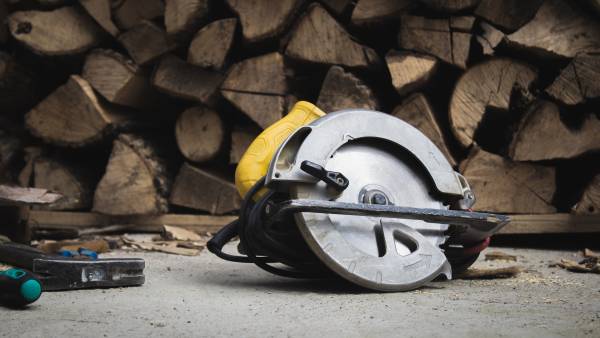Do you frequently get involved in remote jobs involving circular saws? If so, you may wonder, what size inverter to run circular saw?
You must certainly consider power inverters as power tools.
This way, you can easily access your power tool anywhere you want. But are you still uncertain about what size inverter you would require for it to operate effectively?
This depends on the specifications and how you want to use it, just as with any power tool. But a decent-sized inverter can complete the task.
For more information on the sizes (capacities) and types of inverters you should consider for your power saw, continue reading.

What Size Inverter to Run Circular Saw? | The Factors!
Conventional 10.5 inches diameter and 7.25 inches diameter circular saws have 110V/15A. They need 1200 watts while operating and 2400 watts at the start. Therefore, a 3000 watts inverter may power them efficiently.
A 5.5 inches saw will consume fewer running watts, but because of its starting power requirements, you should not accept anything less than a 3000 watts inverter.
1. Power Usage of the Inverter While Using a Circular Saw
Power usage while using a circular saw is one factor to consider when looking for what size inverter to run a circular saw.
Although circular saws come in various shapes and sizes, the most widely used blade sizes are 5.5 and 7.25 inches.
You can also consult the technical specifications section of the circular saw owner manual.
Generally, a 3000 watts inverter is perfect because most circular saws require 2500 watts to start up and 1200 watts to run.
Although a 2500 watts inverter is technically sufficient, extra power should be available in case of a power spike.
The calculating expression: Total watt usage +25% equals the size of the inverter. Similar to inverter size equals amps drawn +25%.
Watts or amps drawn are two different ways to assess power consumption and current drawn, respectively. The saw’s specifications sheet should show you how many watts and amps it needs. You can choose the appropriate inverter for it using that information.
General guidance on how big an inverter should be for particular circular saw sizes are:
- A 5.5 inches circular saw draws 8 amps. It needs 1050 watts of power while operating, and to start, it requires 2100 watts.
- A 6.5 inches circular saw draws 13 amps. It needs 1200 watts to run, and it starts at 2400 watts.
- A 7.25 inches circular saw draws 15 amps. It needs 1300 watts while operating, and it starts at 2600 watts.
These are only examples because, depending on the manufacturer, the specifications could be very different.
Some circular saws measuring 7.25 inches work at 900 watts. Devices like the Hitachi C7YAH, which requires 3360 starting watts and 1680 operating watts to operate, are on the other extreme.
On some circular saws, the lower running watts are not listed; just the higher starting watts are listed.
The starting wattage is probably twice as large as the operating wattage, which is a reasonable assumption. When wattage is specified as 1200 watts, initial or surge power will likely require 2500 to 3000 watts.
Only the circular saw requires an inverter of 3000 watts.
You will want more than 3000 watts if your shed runs on solar power and the inverter powers other gadgets.

2. The Runtime of the Circular Saw on the Inverter
The runtime of the circular saw on the inverter is another factor that answers what size inverter to run circular saw.
What kind of power system you use will determine the runtime of your circular saw on the inverter. An inverter can be used both on and off the grid.
Calculating how much electricity a circular saw uses could be problematic because you don’t use one all the time. Unlike a refrigerator, power tools are only used briefly before being put away, used again, put away, and so on.
So, even though a circular saw could use up to 1200 watts per hour, it will likely use less. Only 600 watts would be used if the saw was operated for 30 to 60 minutes in intervals. If you run it for a shorter period, you might use 300 watts of power.
So, the saw would require closer to 1000 watts if you used it for 45 minutes.
Your inverter can utilize electricity if it is connected to the grid. Any power tool, including a circular saw, can be used for however long it is required.
This applies to all appliances, not just power tools.
However, if the inverter is not connected to the grid, you should use a cordless circular saw.
These instruments can run on batteries for several hours, depending on their use. Choose the cordless versions of most power tools if you are off the grid.
3. Best Inverter for a Circular Saw
After determining the appropriate inverter size, you must decide between a pure sine wave and a modified sine wave inverter.
- Even while pure sine wave inverters are more expensive, they are well worth the money.
- Pure sine wave inverters can drastically lower energy losses and draw amps like you’re utilizing the grid.
- Although a modified sine wave inverter is less expensive, they have trouble handling motors.
- Modified sine wave inverters are often just useful for electronics, while pure sine wave inverters are best for electronics and motors.
This is no longer always the case; many gadgets are made to work with pure sine wave inverters.
4. Necessary Solar Panels to Power a Circular Saw
Solar panels cannot power a circular saw unless it can generate the same amount of power as your inverter.
Solar panels, even if they could, are not a practical option, despite being possible.
For a standard 7.25 inches circular saw to operate, at least ten solar panels of 300 watts are required. It can produce 3000 watts per hour, sufficient to start and run the saw with 10 PV modules.
But you can only use the saw on a bright, clear day. The power supply will be cut off if it starts to rain or the sun sets in the sky.
Another thing to note is that since most circular saws need AC power, solar panels cannot be used to power them. There’s a chance of a direct connection if it requires DC motors. However, many circular saws need AC power; thus, they shouldn’t be linked to solar panels directly. A solar array can be used if there is enough room and the sun is shining.
Depending on where you live, you would likely have 5 to 7 hours of sunlight.
However, solar output decreases as the sun sets and the day grows darker.
Using an Inverter and a Circular Saw | Some Tips!
Here are some recommendations to help you choose the best inverter if you’re still unsure of what size inverter to run circular saw.
You need to consider the Amps, Watts, and Volts.
Circular saw power is measured in amps, but inverter capacity is measured in watts. To determine its wattage, multiply amps by volts.
15 amps, 115 volts circular saw, for instance, consumes 1725 operating watts (15 amps x 115 volts = 1725 watts).
That works out to 1800 watts.
The beginning watts are obtained by doubling that to 2600 watts. Perfect would be a 3000 watts inverter.
Here are some tips to help:
- Get the latest models of circular saws. Compared to prior models, these are more energy efficient. Older power tools feature starting wattages that are treble or higher than operating wattages. They are not helpful for contemporary inverters.
- Invest in a pure sine inverter. Although it was already noted, this must be highlighted. Pure sine is significantly more expensive than modified sine. Indeed, modified sine wave inverters cannot operate many power tools.
- More power is better. You will require a larger inverter than 3000 watts if you plan to utilize many power tools. Yes, that inverter size could power a circular saw, but if you add a drill, an orbital sander, and other devices, the power will soon be depleted.
- Purchase an inverter from a reputable supplier. The inverter is the most delicate of all the components of a solar system. It experiences the most stress and is hence the one that is most prone to break. This is one of the reasons we advise against running it at full power and insist on keeping a few hundred watts in reserve.
- Purchase a good circular saw. With a subpar tool, even the most efficient inverter will perform poorly. Choose a circular saw that is built to function with inverters. You can rely on many well-known manufacturers or consult with technicians for these power tools.
Here’s a video guide for you:
That’s all!
Conclusion
What size inverter to run circular saw, you said? I hope you now know what to do.
Any power tool you use, such as circular saws, will require a lot of power.
Make sure there is enough capacity and reserve available whether you want to power it with electricity or a battery and inverter combination.
This will guarantee that you won’t run out of electricity while working.
Regards.
